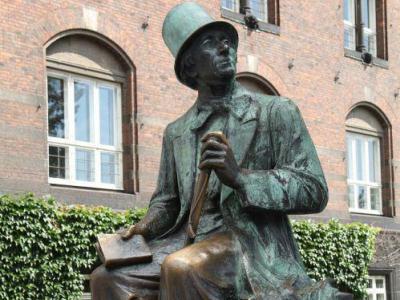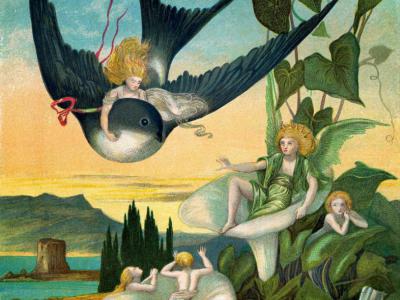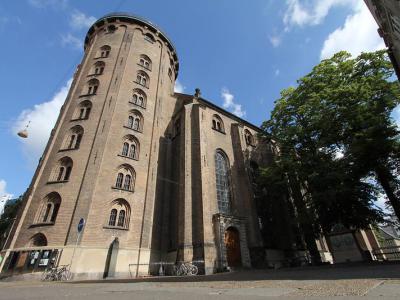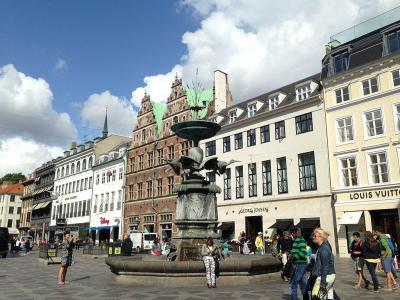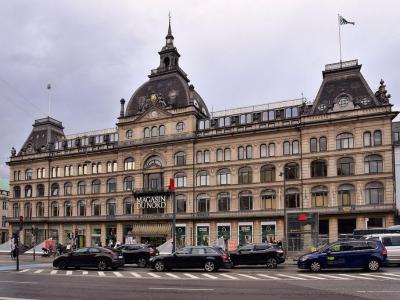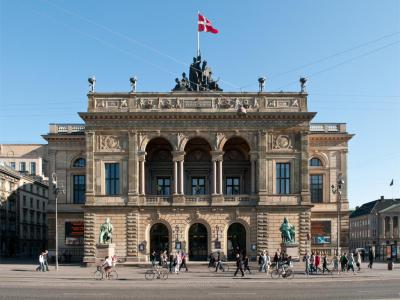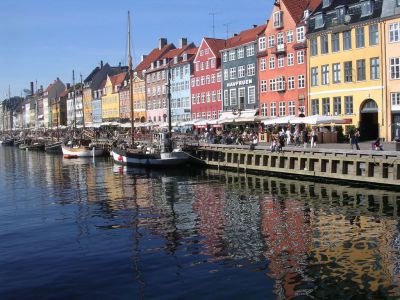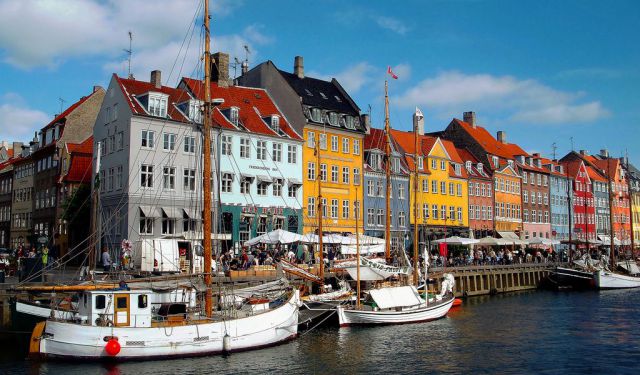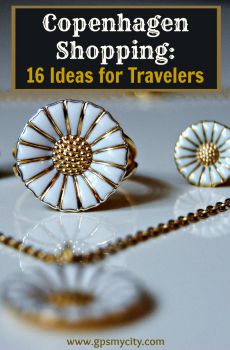
Hans Christian Andersen's Copenhagen (Self Guided), Copenhagen
Above the numerous plays, novels, and poems, the 19th-century Danish author Hans Christian Andersen is primarily renowned internationally as the man who wrote "The Little Mermaid," "The Emperor's New Clothes," "The Ugly Duckling" and many other fairy tales we know since childhood.
Born in Odense (central Denmark) a poor shoemaker's son, Andersen spent most of his life in Copenhagen where he died 70 years later a wealthy writer. Naturally, the country's best-known author left his mark on the capital's landscape with several locations presently attracting literature enthusiasts and curious travelers alike.
The bronze statue of Andersen in the heart of Copenhagen's King's Garden immortalizes the author. Visitors often gather here to pay homage to the man of letters, whose works to date have been translated into 125 languages, a feat bested only by the Bible!
Andersen Fairy-Tale House, situated in Tivoli Gardens, offers a glimpse into the author's creative mind with whimsical displays and interactive exhibits.
Vestergade No 18 is Andersen's former residence and his very first address in the city.
The iconic Round Tower (Rundetårn): While not directly linked to Andersen, its historic charm inspired the writer and found reflection in some of his tales.
Stork Fountain, located on Amagertorv Square, commemorates Andersen's fairy tale "The Storks".
Magasin du Nord: This department store is home to the "Attic Room," a cozy place where Andersen quartered for about a year.
Andersen was a frequent guest at the Royal Danish Theatre (Kongelige Teater) which often showcased the adaptations of his stories. Earlier in life, he was also accepted here as a singer.
The picturesque waterfront area of New Harbor (Nyhavn) was home to Andersen for several decades. Today, you can stroll along the colorful buildings, visit the HC Andersen Café, and take a boat ride to see the city from a different perspective.
In Copenhagen, Hans Christian Andersen's legacy is beautifully preserved, offering visitors a chance to step into the world of his imagination and gain insight into the life of this literary giant. So, come explore these locations with us and discover the magic of Andersen's Copenhagen for yourself!
Born in Odense (central Denmark) a poor shoemaker's son, Andersen spent most of his life in Copenhagen where he died 70 years later a wealthy writer. Naturally, the country's best-known author left his mark on the capital's landscape with several locations presently attracting literature enthusiasts and curious travelers alike.
The bronze statue of Andersen in the heart of Copenhagen's King's Garden immortalizes the author. Visitors often gather here to pay homage to the man of letters, whose works to date have been translated into 125 languages, a feat bested only by the Bible!
Andersen Fairy-Tale House, situated in Tivoli Gardens, offers a glimpse into the author's creative mind with whimsical displays and interactive exhibits.
Vestergade No 18 is Andersen's former residence and his very first address in the city.
The iconic Round Tower (Rundetårn): While not directly linked to Andersen, its historic charm inspired the writer and found reflection in some of his tales.
Stork Fountain, located on Amagertorv Square, commemorates Andersen's fairy tale "The Storks".
Magasin du Nord: This department store is home to the "Attic Room," a cozy place where Andersen quartered for about a year.
Andersen was a frequent guest at the Royal Danish Theatre (Kongelige Teater) which often showcased the adaptations of his stories. Earlier in life, he was also accepted here as a singer.
The picturesque waterfront area of New Harbor (Nyhavn) was home to Andersen for several decades. Today, you can stroll along the colorful buildings, visit the HC Andersen Café, and take a boat ride to see the city from a different perspective.
In Copenhagen, Hans Christian Andersen's legacy is beautifully preserved, offering visitors a chance to step into the world of his imagination and gain insight into the life of this literary giant. So, come explore these locations with us and discover the magic of Andersen's Copenhagen for yourself!
How it works: Download the app "GPSmyCity: Walks in 1K+ Cities" from Apple App Store or Google Play Store to your mobile phone or tablet. The app turns your mobile device into a personal tour guide and its built-in GPS navigation functions guide you from one tour stop to next. The app works offline, so no data plan is needed when traveling abroad.
Hans Christian Andersen's Copenhagen Map
Guide Name: Hans Christian Andersen's Copenhagen
Guide Location: Denmark » Copenhagen (See other walking tours in Copenhagen)
Guide Type: Self-guided Walking Tour (Sightseeing)
# of Attractions: 8
Tour Duration: 2 Hour(s)
Travel Distance: 2.9 Km or 1.8 Miles
Author: EmmaS
Sight(s) Featured in This Guide:
Guide Location: Denmark » Copenhagen (See other walking tours in Copenhagen)
Guide Type: Self-guided Walking Tour (Sightseeing)
# of Attractions: 8
Tour Duration: 2 Hour(s)
Travel Distance: 2.9 Km or 1.8 Miles
Author: EmmaS
Sight(s) Featured in This Guide:
- Hans Christian Andersen Statue
- H. C. Andersen Fairy-Tale House
- Vestergade No 18 – H. C. Andersen's Former Residence
- Round Tower (Rundetarn)
- Stork Fountain
- Magasin du Nord (The Attic Room)
- Royal Danish Theatre (Kongelige Teater)
- Nyhavn (New Harbour)
1) Hans Christian Andersen Statue
Situated in front of the City Hall along the busy H.C. Andersen Boulevard, this whimsical statue of the famous fairy-tale author gazing towards Tivoli Gardens – the amusement park that inspired some of his stories – is a must-see whenever you're in Copenhagen, as an obligatory homage to Denmark's favorite son. His knee is well worn and seemingly inviting you to climb up and have your picture taken – just be warned that, on busy days, you may have to wait a few minutes to do so.
As far as statues of H.C. Anderson go, this has got to be one of the most popular and is very much a part of the city's charm. Don't miss the QR code at the bottom right of the foundation that you can scan to download a sweet little video.
As far as statues of H.C. Anderson go, this has got to be one of the most popular and is very much a part of the city's charm. Don't miss the QR code at the bottom right of the foundation that you can scan to download a sweet little video.
2) H. C. Andersen Fairy-Tale House
An add-on to Ripley's "Believe It or Not!", this small museum details some of H. C. Andersen's life, efforts and achievements including his many travels (which often served as inspiration) and some of his failures, too. The second part includes Andersen's numerous literary works – either written in multiple languages on large cards or set out in characters / lights/ special-effects and narrated on the spot upon the push of a button. Great to relive some stories which may have slipped your mind or learn a few new ones! To complete the experience, have your picture taken with a model of the man himself.
Tip:
You can save money by buying combination tickets with other attractions like Ripley's Believe It or Not! (located in the same building) or Guinness World Records and The Mystic Exploratorium on Strøget pedestrian street (15 minutes away by foot). Copenhagen Card holders get in for free to all attractions!
Tip:
You can save money by buying combination tickets with other attractions like Ripley's Believe It or Not! (located in the same building) or Guinness World Records and The Mystic Exploratorium on Strøget pedestrian street (15 minutes away by foot). Copenhagen Card holders get in for free to all attractions!
3) Vestergade No 18 – H. C. Andersen's Former Residence
When Hans Christian Andersen first planted his feet in Copenhagen on September 6th, 1819, he stayed at the Gardergården inn on Vestergade #18. In the autobiography of his youth, "Levnedsbogen" (not published until 1926), he describes how, after entering Vesterport, he followed some travelers through Vestergade into Gardergården, where he lived in a small room for the first couple of weeks until he had spent all his money and got on the move again. He was only 14 at the time and knew no one in all the great city, but felt certain he could accomplish his goals here.
Most of the buildings on Vestergade date from the years after the fire of 1795; however, the street has had a long history since the Middle Ages, when it linked Gammeltorv (once the most important city square) with the Western City Gate, serving as the principal entrance road for traffic coming from the west.
Several times in the 1930s, '40s and '50s, the Citizens' Representation tried to make the street wider and more traffic-friendly, but both private individuals and associations have put up a fight and it still carries its distinctive weak curve from Medieval times, having fortunately never seen the large traffic regulation that other areas of Copenhagen did.
Most of the buildings on Vestergade date from the years after the fire of 1795; however, the street has had a long history since the Middle Ages, when it linked Gammeltorv (once the most important city square) with the Western City Gate, serving as the principal entrance road for traffic coming from the west.
Several times in the 1930s, '40s and '50s, the Citizens' Representation tried to make the street wider and more traffic-friendly, but both private individuals and associations have put up a fight and it still carries its distinctive weak curve from Medieval times, having fortunately never seen the large traffic regulation that other areas of Copenhagen did.
4) Round Tower (Rundetarn) (must see)
Located in central Copenhagen, the famous 17th-century Rundetårn – or Round Tower – was part of King Christian IV's architectural projects, having been built as an observatory for the famous astronomer Tycho Brahe. Tourists from all over the world come to enjoy the expansive view of Copenhagen from the top after climbing through its 7.5-turn helical corridor.
Astronomy grew to be very important in 17th century Europe and this led to the mushrooming of many observatories. The Rundetårn observatory, originally referred to as STELLÆBURGI REGII HAUNIENSIS, consisted of an academic library, the Trinitatis Church, and a university chapel where scholars spent their time. The tower's well-known spiral ramp was mentioned by architect Lauritz de Thurah as being "of such a strength and breadth that it is even possible to ride and drive up and down the tower on horseback or by carriage – an act that has been done, as is well known, by several of our kings, as well as the Russian Tsar PETER ALEXEWITZ in the year 1716, when His Majesty often rode up and down".
Walking along the ramp, your first stop is a museum/library hall with different installations from contemporary artists, followed by the bells room, and – last but not least – the astronomical observatory with its 360-degree overview.
***HANS CHRISTIAN ANDERSEN'S COPENHAGEN***
Having once housed the University's entire book collection, the Library Hall was regularly visited by Denmark's famous writer, who sought inspiration for his work. If you love Andersen's fairy tales, you will definitely feel their spirit inside Rundetårn. The tower itself was mentioned in "The Tinderbox", wherein the main character – a poor soldier returning home from war – meets a witch, who asks him to climb into a hollow tree to retrieve a magic tinderbox. The witch gives the soldier permission to take anything he finds inside the chambers, but he must return the tinderbox. In the tree, he finds three chambers filled with precious coins guarded by three monstrous dogs, "one with eyes the size of teacups", who guards a vault filled with pennies, one with "eyes the size of water wheels", who guards a vault filled with silver, and one with eyes "the size of Round Tower", who guards a vault filled with gold.
Why You Should Visit:
Not just a tower offering great city views of the city, but a structure full of interest, with its slow increasing grade walkway, some good information as you go, and a gallery half way up. One of the alcoves, about ¾ of the way up, has a thick glass platform that visitors can stand on and look down the building's hollow core!
Tip:
The little café above the church next door has a really cool vibe – perfect for a simple coffee with no crowds. There's also a clean toilet halfway through the tower, as well as a good quality souvenir shop right before accessing the outside balcony.
Astronomy grew to be very important in 17th century Europe and this led to the mushrooming of many observatories. The Rundetårn observatory, originally referred to as STELLÆBURGI REGII HAUNIENSIS, consisted of an academic library, the Trinitatis Church, and a university chapel where scholars spent their time. The tower's well-known spiral ramp was mentioned by architect Lauritz de Thurah as being "of such a strength and breadth that it is even possible to ride and drive up and down the tower on horseback or by carriage – an act that has been done, as is well known, by several of our kings, as well as the Russian Tsar PETER ALEXEWITZ in the year 1716, when His Majesty often rode up and down".
Walking along the ramp, your first stop is a museum/library hall with different installations from contemporary artists, followed by the bells room, and – last but not least – the astronomical observatory with its 360-degree overview.
***HANS CHRISTIAN ANDERSEN'S COPENHAGEN***
Having once housed the University's entire book collection, the Library Hall was regularly visited by Denmark's famous writer, who sought inspiration for his work. If you love Andersen's fairy tales, you will definitely feel their spirit inside Rundetårn. The tower itself was mentioned in "The Tinderbox", wherein the main character – a poor soldier returning home from war – meets a witch, who asks him to climb into a hollow tree to retrieve a magic tinderbox. The witch gives the soldier permission to take anything he finds inside the chambers, but he must return the tinderbox. In the tree, he finds three chambers filled with precious coins guarded by three monstrous dogs, "one with eyes the size of teacups", who guards a vault filled with pennies, one with "eyes the size of water wheels", who guards a vault filled with silver, and one with eyes "the size of Round Tower", who guards a vault filled with gold.
Why You Should Visit:
Not just a tower offering great city views of the city, but a structure full of interest, with its slow increasing grade walkway, some good information as you go, and a gallery half way up. One of the alcoves, about ¾ of the way up, has a thick glass platform that visitors can stand on and look down the building's hollow core!
Tip:
The little café above the church next door has a really cool vibe – perfect for a simple coffee with no crowds. There's also a clean toilet halfway through the tower, as well as a good quality souvenir shop right before accessing the outside balcony.
5) Stork Fountain
Copenhagen has so many statues, but not that many fountains. The Stork Fountain can be found as one wanders along the Amagertorv square, with its fine inlaid Italian granite stonework and its numerous old buildings – the oldest of which dates back to 1600. A highlight for shoppers seeking porcelain and modern Danish design, the square also holds the city's first ever public toilets – still free and very clean (look for the stairs to the underground).
Built in 1888, the Stork Fountain was a present to Crown Prince Frederik and Crown Princess Louise in connection with their upcoming silver wedding anniversary. A popular meeting spot for locals and tourists, it is decorated with various aquatic plants and in the basin, frogs spewing water. On a shelf on the pedestal stand three storks ready to take flight.
Since 1950, it has been a tradition that midwives dance around the fountain as part of their graduation ritual. The key here, of course, would be to time your trip around the summer solstice (or Midsummer), when graduates come by the truckload (not an expression – via actual trucks!) to dance around, and wade/swim in the fountain. Grab a table with a good view of the fountain in the evening, and wait for the show to start!
***HANS CHRISTIAN ANDERSEN'S COPENHAGEN***
The most familiar tale about the stork's role in bringing babies, written by H. C. Andersen, was first published in 1838. They storks know "the pond in which all the little children lie, waiting till the storks come to take them to their parents. The prettiest little babies lie there dreaming more sweetly than they will ever dream in the time to come. All parents are glad to have a little child, and children are so pleased with a little brother or sister." This is probably why the Stork Fountain among the most famous fountains in this part of the world.
Built in 1888, the Stork Fountain was a present to Crown Prince Frederik and Crown Princess Louise in connection with their upcoming silver wedding anniversary. A popular meeting spot for locals and tourists, it is decorated with various aquatic plants and in the basin, frogs spewing water. On a shelf on the pedestal stand three storks ready to take flight.
Since 1950, it has been a tradition that midwives dance around the fountain as part of their graduation ritual. The key here, of course, would be to time your trip around the summer solstice (or Midsummer), when graduates come by the truckload (not an expression – via actual trucks!) to dance around, and wade/swim in the fountain. Grab a table with a good view of the fountain in the evening, and wait for the show to start!
***HANS CHRISTIAN ANDERSEN'S COPENHAGEN***
The most familiar tale about the stork's role in bringing babies, written by H. C. Andersen, was first published in 1838. They storks know "the pond in which all the little children lie, waiting till the storks come to take them to their parents. The prettiest little babies lie there dreaming more sweetly than they will ever dream in the time to come. All parents are glad to have a little child, and children are so pleased with a little brother or sister." This is probably why the Stork Fountain among the most famous fountains in this part of the world.
6) Magasin du Nord (The Attic Room)
A well-established Danish chain of department stores, Magasin du Nord traces its roots back to 1868 when Theodor Wessel and Emil Vett opened a draper's shop in Aarhus. It was an immediate success and two years later the company opened a shop in Copenhagen in rented rooms of the mondain Hotel du Nord. As the department store came to occupy a large part of the hotel, the company adopted the name after it in 1879. By 1889, Magasin du Nord had taken over the entire hotel and proceeded to demolish it together with a neighbouring structure. Completed in 1894 in a French Renaissance Revival style, the current building became the most beautiful department store of its day – a place where modern man could be awestruck by everything the great wide world had to offer. Inspiration came from all corners of the globe, and the goods from Paris, Berlin and London, as well as Copenhagen's own illustrious fabric and furniture factories.
Magasin du Nord continues to offer great shopping stores and good quality products to this day. Each of the five floors have their men's, women's and children's department while the rest is taken up by kitchen accessories, home decors, computers and gadgets, sports and luggages, etc. On the ground floor most displays feature perfumes, beauty brand products and designer brands bags, and you'll find two spot places of Joe & The Juice. The underground is where you'll find the food market, a selection of great wines, sport magazines, flowers, chocolates and cake-coffee shops.
***HANS CHRISTIAN ANDERSEN'S COPENHAGEN***
Go and have a look at the attic room that 22-year-old Andersen rented from 1827 to 1828 and where he scribbled some of his poems. You gain entrance through the store and it is situated on the third floor, where you will see a picture of the famous former tenant's distinctive face on the wall. Continue down the hallway and through a meeting room until you see the attic room on your right. There are not a lot of bells and whistles inside, but the tiny space surely exudes a certain poignancy. Entrance is free and opening hours are Thu/Fri: 1–5pm; Sat/Sun: 11am–3pm.
Magasin du Nord continues to offer great shopping stores and good quality products to this day. Each of the five floors have their men's, women's and children's department while the rest is taken up by kitchen accessories, home decors, computers and gadgets, sports and luggages, etc. On the ground floor most displays feature perfumes, beauty brand products and designer brands bags, and you'll find two spot places of Joe & The Juice. The underground is where you'll find the food market, a selection of great wines, sport magazines, flowers, chocolates and cake-coffee shops.
***HANS CHRISTIAN ANDERSEN'S COPENHAGEN***
Go and have a look at the attic room that 22-year-old Andersen rented from 1827 to 1828 and where he scribbled some of his poems. You gain entrance through the store and it is situated on the third floor, where you will see a picture of the famous former tenant's distinctive face on the wall. Continue down the hallway and through a meeting room until you see the attic room on your right. There are not a lot of bells and whistles inside, but the tiny space surely exudes a certain poignancy. Entrance is free and opening hours are Thu/Fri: 1–5pm; Sat/Sun: 11am–3pm.
7) Royal Danish Theatre (Kongelige Teater)
Although a new ultramodern Opera House was inaugurated across the canal in 2005, this Baroque-style creation, dating from 1874, was for years the country's main national performance venue, hosting opera, ballet and drama under one roof – though today it is largely used for ballet. Initially the theatre of the king, it is the grandest building on Kongens Nytorv square, having certainly retained a unique atmosphere with its historic ceiling paintings high above and the stunning big chandelier in the theater hall. Outside the main entrance, the statue on the left depicts Adam Oehlenschläger, an author of tragedies, while across from him is the image of Ludvig Holberg, a satirist whose comedic works are still popular.
Besides seeing a production here (try booking in advance for best seats), you can take a 90-minute tour during the daytime and thus get the opportunity to step in the royal box, visit the wardrobe room where costumes are made and fitted, and stand on the stage. It's all very affordable and could even be one of the highlights of your trip!
***HANS CHRISTIAN ANDERSEN'S COPENHAGEN***
As a dreamy, penniless 14-year-old, H. C. Andersen has tried his luck as an actor, singer and dancer here, though the audition was, by all accounts, a fiasco. He soon turned to writing, but his early plays were turned down, too. Fortunately, in his third year of big city dwelling, the head of the theatre arranged for Andersen to attend grammar school in other parts of Zealand for the next five years. This helped him get a place at Copenhagen's university, where his writing really hit its stride.
Besides seeing a production here (try booking in advance for best seats), you can take a 90-minute tour during the daytime and thus get the opportunity to step in the royal box, visit the wardrobe room where costumes are made and fitted, and stand on the stage. It's all very affordable and could even be one of the highlights of your trip!
***HANS CHRISTIAN ANDERSEN'S COPENHAGEN***
As a dreamy, penniless 14-year-old, H. C. Andersen has tried his luck as an actor, singer and dancer here, though the audition was, by all accounts, a fiasco. He soon turned to writing, but his early plays were turned down, too. Fortunately, in his third year of big city dwelling, the head of the theatre arranged for Andersen to attend grammar school in other parts of Zealand for the next five years. This helped him get a place at Copenhagen's university, where his writing really hit its stride.
8) Nyhavn (New Harbour) (must see)
Established by King Christian V in the 1670s along with Kongens Nytorv (the downtown main square), Nyhavn ("New Harbor") is a recently gentrified sailors' quarter. With its exquisitely constructed townhouses made of bricks, wood and plaster, the whole stretch is a wonderfully colorful place to hang out. Go to the south of Nyhavn and you'll find huge, lavish mansions along the canal, or just work your way through the maze of trendy cafés, jazz clubs, and tattoo shops.
Fancy a drink? Take your beer out to the canal and feel like a local, or take a walk down Nyhavn all the way to the end, where you will find Skuespilhuset (part of the Royal Theatre) and its reasonably priced bar/café, with good quality service and one of the best views in town (of the harbour, the new Opera House, and other things, too). Those with tired feet may alternatively opt to take an hour-long boat tour, usually booked just at the entrance to the harbor.
***HANS CHRISTIAN ANDERSEN'S COPENHAGEN***
The Danish author lived in the area for quite a while, back when it was was most notorious for sailors, beer and prostitution. Between 1834-38, he wrote his first stories ("The Princess and the Pea", "The Tinderbox") on the 2nd floor of the bright red building at #20, and ended up occupying two other canal-front houses over four decades – one of which is right next door at the mustard-colored #18. Both houses are best viewed from the bridge midway along the canal. His longest lodging stint, however, was at #67, where he lived on and off between 1848-65. The bottom floor of the white building is now a café.
Why You Should Visit:
Perfect picturesque place to end a long day. You can do as the locals do: enjoy a beer/coffee from a nearby store, rest your feet at the quayside and enjoy the view.
Fancy a drink? Take your beer out to the canal and feel like a local, or take a walk down Nyhavn all the way to the end, where you will find Skuespilhuset (part of the Royal Theatre) and its reasonably priced bar/café, with good quality service and one of the best views in town (of the harbour, the new Opera House, and other things, too). Those with tired feet may alternatively opt to take an hour-long boat tour, usually booked just at the entrance to the harbor.
***HANS CHRISTIAN ANDERSEN'S COPENHAGEN***
The Danish author lived in the area for quite a while, back when it was was most notorious for sailors, beer and prostitution. Between 1834-38, he wrote his first stories ("The Princess and the Pea", "The Tinderbox") on the 2nd floor of the bright red building at #20, and ended up occupying two other canal-front houses over four decades – one of which is right next door at the mustard-colored #18. Both houses are best viewed from the bridge midway along the canal. His longest lodging stint, however, was at #67, where he lived on and off between 1848-65. The bottom floor of the white building is now a café.
Why You Should Visit:
Perfect picturesque place to end a long day. You can do as the locals do: enjoy a beer/coffee from a nearby store, rest your feet at the quayside and enjoy the view.
Walking Tours in Copenhagen, Denmark
Create Your Own Walk in Copenhagen
Creating your own self-guided walk in Copenhagen is easy and fun. Choose the city attractions that you want to see and a walk route map will be created just for you. You can even set your hotel as the start point of the walk.
Little Mermaid Walking Tour
Back in the 18th century, Denmark was in the throes of an economic boom. Constructed during the reign of King Frederick V (hence the name), the district of Frederiksstaden attests to that with its beautiful architecture, measuring up to the projects from the same period in Berlin, Paris, and Vienna. This tour will guide you through the area's broad streets lined by bourgeois houses, mansions,... view more
Tour Duration: 2 Hour(s)
Travel Distance: 2.8 Km or 1.7 Miles
Tour Duration: 2 Hour(s)
Travel Distance: 2.8 Km or 1.7 Miles
Castle Island (Slotsholmen) Walking Tour
Traditionally seen as the birthplace of Copenhagen, Castle Island (Slotsholmen) gave rise to the Danish capital with a small fortress built on it in the 12th century AD. Since the Middle Ages, this area, also known as the "Island of Power," has been the center of Denmark's government. It houses several prominent landmarks that played significant roles in the country's history.
... view more
Tour Duration: 1 Hour(s)
Travel Distance: 1.6 Km or 1 Miles
... view more
Tour Duration: 1 Hour(s)
Travel Distance: 1.6 Km or 1 Miles
Latin Quarter Walking Tour
One of the most interesting, young-spirited neighborhoods of Denmark's capital, the Latin Quarter is well known for its hangout spots, alternative shopping, and 18th-century architecture.
Back in the Middle Ages, the area surrounding Our Lady's Square (“Frue Plads” in Danish), right in the heart of it, was considered a “ray of light” in the overall darkness of those times. A... view more
Tour Duration: 1 Hour(s)
Travel Distance: 1.7 Km or 1.1 Miles
Back in the Middle Ages, the area surrounding Our Lady's Square (“Frue Plads” in Danish), right in the heart of it, was considered a “ray of light” in the overall darkness of those times. A... view more
Tour Duration: 1 Hour(s)
Travel Distance: 1.7 Km or 1.1 Miles
Copenhagen Introduction Walking Tour
A fairy tale of a city, full of peculiarities, Denmark's capital Copenhagen has a fairly straightforward etymology. It derives from Kopmannahafn, which roughly translates to “merchant's harbor”, and reflects the city's origin as a place of commerce by the harbor. Originally a Viking fishing village called Havn (port), established in the 10th century near today's Gammel... view more
Tour Duration: 2 Hour(s)
Travel Distance: 2.7 Km or 1.7 Miles
Tour Duration: 2 Hour(s)
Travel Distance: 2.7 Km or 1.7 Miles
Useful Travel Guides for Planning Your Trip
Copenhagen Shopping: 16 Distinctively Denmark Things to Buy
Denmark is renowned for simple, industrial and functional design, as well as bohemian and everyday fashion-wear for the individual urban living. The capital Copenhagen, home to Copenhagen Fashion Week twice a year and biannual INDEX: Design to Improve Life - the world’s biggest design awards, is...
The Most Popular Cities
/ view all
